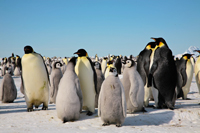Antarctic zoological research
People
G.Allegrucci, V.Sbordoni, A.Fabiani, R.Palozzi
Weddell seal
The first Italian project on the Antarctic Weddell seal (Leptonychotes weddelli), funded by the National Program for Antarctic Research (PNRA) is currently in progress in our laboratory. We developed non-invasive methodologies to identify individual DNA (mitochondrial markers) and feeding ecology (stable isotope analyses) of the population of Baia Terranova. Here, the local environment is different from that of American Station of McMurdo (only few hundreds km far away), and our aim is to investigate how the seals have adapted and if these differences result in a detectable population genetic structure and/or in different diving/feeding strategies. Although the DNA sequences from Baia Terranova showed similarities with those from McMurdo, preliminary genetic results showed new aplotypes that differentiated from the American samples. Similarly, also the isotope analyses gave interesting results.
People
G.Allegrucci, G.Carchini, V.Sbordoni, V.Todisco
Chironomidae insects
In collaboration with the British Antarctic Survey (BAS, dr. Peter Convey) speciation process have been studied in the chironomid midges (Diptera), Belgica antarctica, Eretmoptera murphyi (subfamily Orthocladiinae) and Parochlus steinenii (subfamily Podonominae). These are the only Insect currently found in Antarctica. Analysis of cox1 sequences in B. antarctica highlighted a strong genetic structure between populations obtained from different locations along the Antarctic Peninsula and the South Shetland Islands archipelago, with a number of distinctive mtDNA lineages inhabiting geographically distinct areas. Genetic patterns shown by each haplogroup have probably been determined by historical dispersal and colonization events during the Pleistocene, and are consistent with their survival in refuges in situ during successive glacial maxima over this period.
G. Allegrucci, G.Carchini, P.Convey, V. Sbordoni. 2012. Evolutionary geographic relationships among orthocladine chironomid midges from maritime Antarctic and sub-Antarctic islands. Biol. J. Linn. Soc., 106: 258-274.
R.Palozzi. 2010. The ontogeny of foraging in Weddell seal pups and dietary behaviour in lactating females. PhD Thesis in Evolutionary Biology and Ecology, Tor Vergata University, Roma, Italy.
G.Allegrucci, G. Carchini, V. Todisco, P. Convey and V. Sbordoni. 2006 - A molecular phylogeny of antarctic chironomidae and its implications for biogeographical history. Polar Biology, 29: 320-326.
G. Allegrucci, V. Todisco, V. Sbordoni and G. Carchini -2005- Progress in molecular phylogeny of Antarctic Chironomidae. In: P.Luporini & M.Morbidoni (eds.), “Proceedings of the fifth PNRA meeeting on Antarctic Biology” 29-30 April 2004, Messina. Polarnet Technical Report, 1(2005): 58-62.
